Charles Curry. Alex Petrovic. Charlie Wheeler. Three men – county administrative judges – who were instrumental in saving both major league baseball and pro football in Kansas City. The year was 1967. It was the 13th season for the A’s in Kansas City – it would also be their last. The Chiefs had moved from Dallas in 1963, but playing in a retrofitted baseball stadium was not going to work in the long run. These three men held the key.
I began thinking about this post earlier this year when Charlie Wheeler approached Bill Lochman and me at lunch. Bill and I (and often Jim Graham) meet monthly for a Saturday lunch at Grand Street Café. Charlie is there almost every Saturday with a group of friends to talk politics and policy. Bill and I have known Charlie since the 1960’s, so we sometimes briefly chat with him. But this time he came over to our table and sat down. He was on a mission. He wanted to talk about his race for President. Of the United States. Charlie is 92 years old.
The Kansas City Blues: Charlie’s age gives me the first baseball angle to this post. When Charlie joined Bill and me at lunch, Bill had a question for him. Did Charlie remember Walt Lochman (Bill’s father)? Charlie immediately said sure, the Kansas City Blues broadcaster. From 1935 to 1942, as Charlie grew from age 9 to 16, Walt Lochman was the play-by-play radio voice for the minor league Kansas City Blues. Below, in a photo from a 1939 Blues/Yankees exhibition game in Kansas City, Walt interviews center fielders Joe DiMaggio of the Yankees and his brother Vince DiMaggio of the Blues.
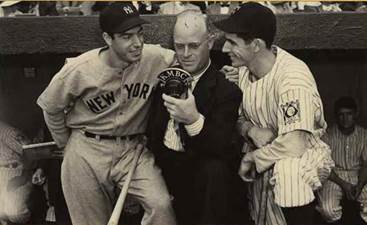
The Kansas City A’s: The Blues gave way to the major league Kansas City A’s in 1955. In December of 1960, Charlie Finley bought the A’s and immediately began looking for excuses to move to another city. He floated Dallas/Fort Worth. Then Oakland. He dropped those attempts without a league vote. He persisted in 1964, but lost on a 9-1 vote for a move to Louisville. During this same period of time, local county government was going through major changes that had nothing to do with baseball. Until they did.
Charles Curry and the CCP: In 1962, businessman Charles E. Curry was elected Presiding Judge of Jackson County. Not to be confused with trial judges, the county government was then run by three administrative judges (Presiding, Western and Eastern). Charles Curry was a “white hat” reformer who started recruiting like-minded Democratic candidates for other county offices. The first success for Curry’s Committee for County Progress was Dr. Charles B. Wheeler who was elected Coroner in 1964.
In 1966, Curry ran for reelection on a ticket with Wheeler for Western Judge and Alex Petrovic of Sugar Creek for Eastern Judge. They all won. So did Kansas City sports fans, but they did not yet know it. Below, on primary election night – Petrovic, Curry and Wheeler. Some of the other winners on the CCP team were George Lehr (County Collector and future State Auditor), Joe Teasdale (Prosecutor and future Governor), Bruce Watkins (Circuit Clerk and first black to hold countywide office) and Bernice Conley (County Clerk and first woman to hold countywide office).
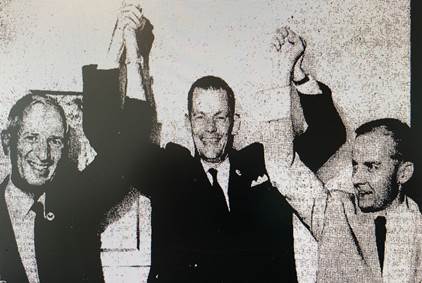
1929 and 1931 Bond Issues – Harry Truman: Curry and Petrovic had a famous predecessor in office. Harry S. Truman, with the help of the Pendergast machine, was elected Eastern Judge in 1922. He lost a run for the same office in 1924 when the national Coolidge landslide helped many local Republicans. Truman bounced back in 1926 to win the Presiding Judge slot and was reelected in 1930. During his county tenure, Truman set some important precedent for the Curry/Petrovic/Wheeler court.
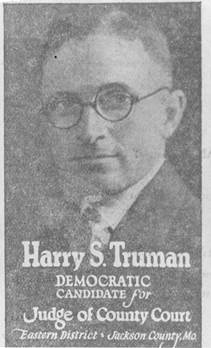
Truman thought the county road system was abysmal and fought for the first-ever major bond issue to improve roads and bridges. Tom Pendergast told him that it would not pass because the people would just think money would be siphoned off by the machine. Truman proceeded anyway, blanketing the county in a series of meetings to convince voters that the improvements were necessary and to personally assure them that the money would be used honestly. To determine the best plan for use of the funds, he formed a bipartisan commission headed by two engineers, one a Republican and one a Democrat. In 1928, the voters said yes to the roads and a hospital, and in 1931, they approved the funding of a juvenile home, a new Kansas City courthouse and renovation of the Independence courthouse.
1967 County Bond Issue: Fast forward to 1967. The needs were almost parallel to those addressed by Truman: roads, hospital, flood control, parks, juvenile facilities and courthouse renovation. And one new big thing – a two-stadium complex for major league baseball and NFL football. The innovative design included a rolling roof that could cover either stadium during inclement weather. The new county court had excellent political capital after the election. There was a good chance that this could be leveraged to improve the infrastructure of Jackson County. The court voted to put the issues on the ballot.
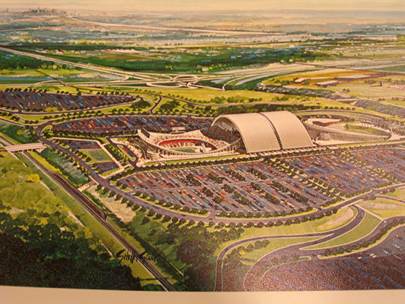
The Campaign for Jackson County Votes: For the campaign, the county court followed the Harry Truman model. The judges sought bipartisan support, and part of this was already built in to the Jackson County Sports Complex Authority that was set up to oversee operation of the stadiums. The Authority had Republican and Democratic members, and its chairman was a prominent Republican, Dutton Brookfield.
And just like Truman, they took the show on the road. The judges and their surrogates fanned out in the community to campaign for the bonds. There was a series of “Bondwagon” shows with entertainment and a pitch by a county judge in support of the bonds. There was also a logo and slogan: CUGA, “Catch Up, Go Ahead.”
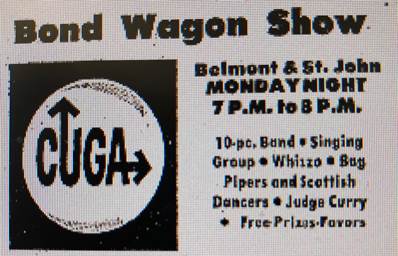
Petrovic thought the sports complex should be named after Truman, and the other judges agreed. To get official permission, Alex visited Truman at home and presented him with an artist’s conception of the complex signed by the judges, Dutton Brookfield and Charles Deaton, the designer of the dual stadium idea. In a later visit with all three judges, Truman publically endorsed the bonds and asked for Curry’s CUGA button which Petrovic pinned on Truman.
The Stadiums: Another big “on the road” item was a mobile exhibit of the two-stadium complex. The exhibit was taken to scores of locations throughout the county. The judges were often joined by players from the Kansas City Chiefs (Len Dawson, Curtis McClinton, Buck Buchanan, etc.). Below, Chiefs halfback Gene Thomas (left) was part of the campaign team.
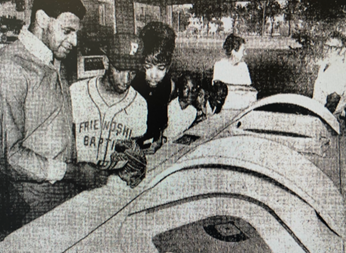
The overall bond program was divided into seven ballot issues. Polling indicated that all would pass except for the sports complex. Although about 60% favored the issue, it took a two-thirds approval to win. The Chiefs had been helping with the campaign, but the poll energized them even more. The Chiefs volunteer Red Coaters, the players and team executives, including owner Lamar Hunt, were everywhere.
Notably absent from the campaign: Charles O. Finley. The prospect of a new baseball stadium did not deter Finley from his quest to move the A’s. So the voters were being asked to finance stadiums for the Chiefs and a baseball team to be named later.
Election Night, June 27, 1967: All seven bond issues passed. The stadium bonds were approved by a 68.9 % vote (61,872 to 27,878). At his first-ever election night party, Lamar Hunt gushed. Grocery magnate and super-fan Les Milgram blew his signature trumpet so people would respond with the Chiefs call of “Charge!” Alex Presta, one of the “black hat” political leaders, bragged that his wards had delivered big for the bonds. This was good evidence that Curry and his allies had worked hard to bring everyone on board.
Chiefs General Manager Jack Steadman: “Because Jackson County stepped up to the plate, Kansas City became a major league city.” He called the politicians who led the effort “giants.” The Chiefs could prepare for their future in Arrowhead Stadium. As for baseball, there was still a big question mark. On election night, Finley was at home in La Porte, Indiana. He had no comment on the election.
The Campaign for MLB Owners Votes: Two weeks after the election, the All-Star game was in Anaheim, and so the county judges again took their show on the road. They rolled out the mobile stadium exhibit to curry (pun intended) favor with MLB owners. Below, Charlie Wheeler at right and Alex Petrovic behind him. Sports Authority chair Dutton Brookfield assured Finley that the county was not trying to go around him, but had little choice since Finley was ignoring them.
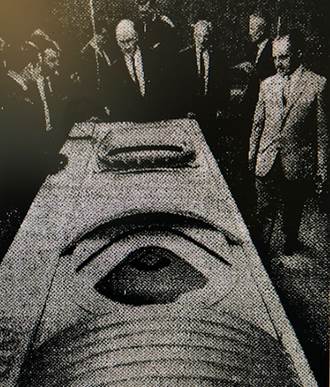
[Note on Photos: The bad news is that some of the photos in this post are grainy. The good news is that they are available online. The Mid-Continent Public Library provides free access to the archives of the Kansas City Star and Kansas City Times. All you need to do is sign up for a library card. My thanks to the library.]
Goodbye Charlie O. Hello Mr. K: Finley continued to be evasive. In a lead editorial in the Times on July 20, it was noted that Finley had finally broken his “ominous silence” by talking to the Sports Authority members who travelled to Chicago to meet with him. Finley brought in a consultant to compare Oakland, Seattle and KC, but as Mayor Ilus Davis pointed out, the San Francisco-based consultant likely had some bias. This process drug on through the end of the season. By then, the American League owners were tired of fighting Finley. On October 18, they approved his move to Oakland. But the AL could not ignore Kansas City and its planned baseball-only stadium. They promised Kansas City a new team by 1971.
The Kansas City contingent pushed back, asking for a team by 1969. Senator Stuart Symington came in to help plead the case. It was not lost on the owners that they did not want an enemy in the Senate. On October 20, the league saw the light and agreed to 1969 for expansion teams in Kansas City and Seattle.
Kansas City needed an owner, and five proposals came in. The strong interest was no doubt aided by the knowledge that a new stadium was on the horizon. Ewing Kaufman was picked as the owner, and the Royals were born.
Stadium Legacy: The county judges likely did not realize they were creating a legacy that extended beyond the Truman Sports Complex. In initial planning, it was assumed there would be a single multipurpose stadium for both sports, just as most cities had been doing. Below, an early proposal for a downtown domed stadium:

But Denver designer Charles Deaton presented a layout that enamored Lamar Hunt and Jack Steadman of the Chiefs: two adjacent stadiums that each could be built with sight lines and capacity to match the sport. Steadman was already concerned about the capacity because he thought the Chiefs could draw 75,000 fans. There was no way that would work with a multipurpose stadium. But the key factor may have been the Chief’s frustration with the uncooperative A’s owner Charlie Finley. With the baseball situation in limbo, the Chiefs felt their best path was to have their own stadium.
Deaton’s design (sans roof) was implemented by project architects Kivett and Myers of Kansas City. The line of sports architects that started with Kivett and Myers remains in Kansas City to this day at the firm known as Populous. Although it took some time for other cities to follow the Jackson County lead, most stadiums are now single use. That has been good news for Populous – the company has designed about 20 of the 30 current MLB stadiums.
Roofless in Kansas City: In the end, budgetary concerns resulted in the deletion of the rolling roof. There was some grumbling about that, but in the end two grand stadiums were built. The voters were given another chance on a sliding roof in 2006. There were two issues on the ballot, one for renovating the stadiums, the other for the roof. The renovations passed with 53% of the vote, but the roof lost at 48%. This gives some perspective to just how impressive the victory had been in 1967 when the law required a two-thirds majority.
As for the three judges who engineered that 1967 victory, the politics of strange bedfellows came into play.
1968 and 1970 Elections: The CCP team followed with resounding victories in 1968, taking all nine county offices up for election that year. But some of those winners were on a collision course. Tension was also in the air at the County Court where Wheeler was sometimes at odds with Curry and Petrovic. Curry chose to not run again in 1970. Wheeler wanted to move up to Presiding Judge, but so did County Collector George Lehr. Prosecutor Joe Teasdale was looking at Western Judge, as was Harry Wiggins, the head of state liquor control. Lehr and Wiggins teamed up and got the CCP endorsement plus strong faction support (i.e., the “black hats” that had lost to the CCP in prior elections). Petrovic was again endorsed by the CCP, but he did not have faction support. Wheeler and Teasdale ran as a team and were defeated by Lehr and Wiggins. Petrovic lost to Joe Bolger. The three members of the county court that pulled off the bond issue victory were all gone before a game could be played in either stadium.
[County Court Trivia: The 1970 election was the last for a County Court. In 1972, a new county charter took effect and George Lehr’s title changed from Presiding Judge to County Executive. As for the other two judges, Joe Bolger became a member of the new county legislature and Harry Wiggins ran for the state senate in 1974, serving there for 28 years. One of the new county legislators in 1972 was Mike White who famously won by one vote. Two years later, I had the pleasure of being Mike’s campaign manager when he became the first elected County Executive.]
Charles Curry: Below, in a photo taken at the Truman Library, Judge Curry is on the left and his father Charles F. Curry is on the right. The photo is undated, but it’s likely around 1967 when Petrovic joined Judge Curry on the county court. That’s Alex in the middle with former President Truman.
The senior Curry knew Truman from the American Legion in the 1920’s. He thought Truman had an outstanding record as Presiding Judge, and this was backed up by Curry’s longtime friend Alex Sachs. Sachs was the County Highway Engineer who implemented much of Truman’s successful county road program. Curry suggested that he and Sachs form a Truman for Governor Committee. Truman sent word back that he appreciated the thought, but might have other plans. Yes he did, and Curry became an early supporter of Truman’s 1934 Senate race.

After leaving the county court, Judge Curry floated possible runs for governor and senator, but never again held public office. He kept his hand in local politics for a while, but found his niche in national politics. He was Missouri chair of Henry “Scoop” Jackson’s run for president in 1976. He was part of the national effort to pass the Equal Rights Amendment. Curry was active in the Democratic National Committee and became its treasurer in 1981. He was instrumental in modernizing the fund-raising arm of the DNC. He died in 2010 at age 92.
Alex Petrovic: Alex did not go back as far as the Curry family with Truman, but there is a great picture of Alex (hand raised) in the lawn of the Truman home in 1948. It was election night, and a crowd began gathering overnight as late returns showed that Truman had upset Dewey.
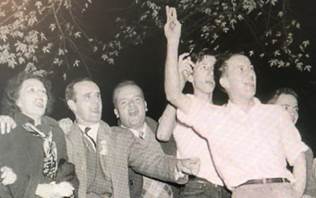
The election loss by Alex in 1970 was devastating to those of us in his political circle. I was not active in politics until 1968, a year out of law school. My high school friends Bill Lochman and Jim Graham had lured me to their Young Democrats Club that was closely tied to the CCP, and in particular Alex Petrovic. Alex was funny. A story teller. A good man. He was a political hero to me. After his loss, Alex stayed active as a CCP leader and became well known as the spokesman for St. Joseph Hospital.
For many years, I joined Alex’s former aide Pat Hininger and Curry’s former aide Charlie Hart for an annual pilgrimage to Sugar Creek to see Alex. He held court with his great stories, often punctuated with his uncanny impersonations of politicos, including Curry and Wheeler. He never let us leave without a jar of his personally canned peppers and a bag of his specialty popcorn. We did this until he died in 2015 at the age of 92.
Mayor Charlie Wheeler: Hardly missing a beat, Charlie ran for mayor of Kansas City in 1971. The city races are nonpartisan, but the two candidates in the general election were well known by their party labels: Charlie, the Democrat, and Dutton Brookfield, the Republican chair of the Sports Authority. Just four years earlier, they had worked together on the stadium bond issue. Brookfield was supported by prominent Democrats Charles Curry and Ilus Davis, plus the Citizens Association and constant editorializing from the Star. But Charlie was able to hold on to most of the Democratic support and won with 55.5% of the vote. He wrote a book (Doctor in Politics) that is a diary of the campaign and his early months in office He was reelected in 1975. Under his watch, another major sports facility was opened – Kemper Arena.
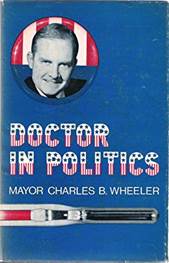
During his second term, Charlie announced that he was running for the 1976 Democratic nomination to be Vice President. There was no mechanism for this, but he got tons of publicity. I was Jackson County Democratic Chairman at the time and jumped on board with almost every other local Democrat. It was all in good fun, but in the end, Charlie had to seek an office that had an actual filing process. So he chose the Senate race of 1976 where Jim Symington, Jerry Litton and Warren Hearnes were already running to succeed the retiring Stuart Symington.
I was supporting Jim Symington, and Charlie objected because I was the local party chair. I pointed out that this was not unusual, especially in a statewide race, and besides, he did not complain when I supported his VP effort. This was in the days when there was extensive newspaper coverage of local races, and Charlie got a lot of headlines out of his complaint. He even bragged that he had developed the “Shalton Spin” to turn toward Symington in joint appearances to debate the issue. I don’t think he actually ever did that. Again, all in good fun, as Charlie was polling fourth in a three-man race. The campaign ended tragically when the winning nominee Jerry Litton was killed in a plane crash on primary election night.
1979 Mayor’s Race and Baseball: Charlie ran for a third term as mayor, but he had lots of competition. Council members Joe Serviss, Bruce Watkins, Joel Pelofsky and Dick Berkley also filed. I was set to back Joe Serviss, but he dropped out. I stayed out of the primary, but did get quoted for my “elaborate baseball scenario for the election.” In a Bill Turque column in the Star, I likened Dick Berkley to George Steinbrenner, well-heeled owner of the Yankees, who was accused of buying pennants. Wheeler’s 1975 strategist Jerry Jette had been hired away by Berkley, reportedly to keep Jerry from working against Berkley. This compared to the Yankees signing Luis Tiant to keep Tiant from beating them while pitching for the Red Sox. The cash-light Pelofsky was Bill Veeck, hustling owner of the White Sox who seemed to be holding his franchise together with chewing gum. Charlie Wheeler was of course Charlie Finley. Bruce Watkins was Jackie Robinson, attempting to become the first black mayor of the city. I considered the dropout Joe Serviss to be on injured reserve.
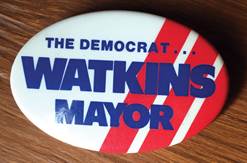
In a close race, Berkley and Watkins survived the primary. Just like in 1971, the candidates were well known by party affiliation even though city races are nonpartisan. But unlike 1971 when Wheeler got most of the Democratic support, Watkins was not so lucky. Many of the factions stayed out of the race. The CCP does not endorse in city races, and so many individual CCP members were in opposite camps. The Republican Berkley picked up some key Democratic support, notably influential CCP stalwart Jim Nutter. I was CCP chair at the time and worked on the Watkins campaign side-by-side with none other than Charles Curry who came on board to raise funds for the man he helped elect on the 1966 CCP ticket as the first black to hold countywide office.
Berkley won and would go on to serve three terms. But those of us who worked for Bruce like to think we laid some groundwork for future Kansas City mayors and members of Congress.
Charlie Wheeler – The Energizer Candidate: Charlie just kept on running. He never met a race he didn’t like. He struck gold in 2002 when he won the state senate seat held by the retiring Harry Wiggins, the person who had succeeded Charlie as Western County Judge back in 1970. During that 2002 campaign, the 75-year-old Wheeler said he expected to defy actuarial charts. “If you weather the stormy decade between 55 and 65, you stand a reasonable chance of living to be 100.” Using his MD background (he also has a law degree), he gave a scientific explanation of the aging process, “The main problem with aging is that people’s chromosomes begin to fray at the ends.”
After serving one term in Jefferson City, he started a new string of campaigns that did not pan out with victories: 2006 – County Executive; 2008 – State Treasurer; 2011 – Mayor; 2016 – Governor. Undeterred, he is now running for President.
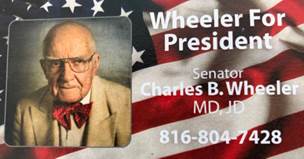
Two days ago, Bill Lochman and I were having lunch at Grand Street and Charlie again came over the talk with us. He was joined by one of his regular Saturday tablemates, Judge Howard Sachs (a bit older than Charlie – 93). They asked us questions about local and state issues that they had been discussing with their group. I hope that when I am in my 90’s that I have their passion, spirit and vitality. There is also a small world story here: Judge Sachs is the son of Truman’s County Highway Engineer Alex Sachs, mentioned above in the Curry history.
I asked Charlie about his race for President, and he was not sure how long it would continue. I can see that his message might get lost when there are at least 20 other candidates in the race for the Democratic nomination. But Charlie has a credit that no other candidate can offer. He is the only candidate in the field who has an airport named after him.
The County Court and Stadium Anniversaries: On opening day in 2013, the Royals honored Charlie by having him sit in the Buck O’Neil Legacy Seat. The Royals promotion said it was for his years of public service including two terms as Mayor of Kansas City. They left out the best part: Charlie’s time as Western Judge that helped make that seat and the whole stadium a reality. Charlie did not forget. He brought along Eastern Judge Alex Petrovic.
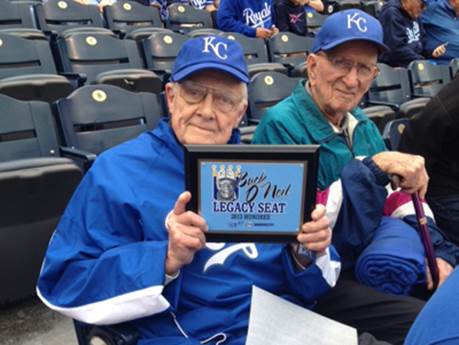
In 2021, the Chiefs will begin their 50th season playing at Arrowhead Stadium. In 2022, the Royals will do likewise at Kauffman (nee Royals) Stadium. For those 50th anniversary celebrations, here’s hoping that the teams recognize Charles Curry, Alex Petrovic and Charlie Wheeler for their contribution to major league baseball and pro football in Kansas City.
I’m also thinking that the celebrity who throws out the first pitch at the Royals opener in 2022 should be the then 95-year-old President Charles B. Wheeler.
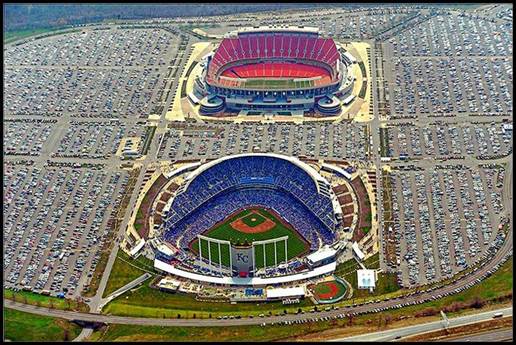
Lonnie’s Jukebox: On the “Bondwagon” circuit in 1967, someone composed a jingle for campaign events:
There are seven reasons why the voters ought to vote “yes”
Yes, seven good steps toward Jackson County progress
For just 90 cents a month, that’s about what it will be
There’s a better, brighter future waiting just for you and me
Let your money go for modernization
Vote for the County bonds
I have no idea of what music went with these lyrics.
In other music news from 1967, I must say it was quite a year for #1 hits. The Monkees had long runs at #1 at both the beginning and end of the year (“I’m a Believer” and “Daydream Believer”). The Beatles hit #1 three times (one week each) with “Penny Lane,” “All You Need Is Love,” and “Hello, Goodbye.” Other #1’s: “Kind of a Drag,” “The Happening,” “Groovin’,” “Respect,” “Windy,” “Light My Fire,” “The Letter,” and “To Sir With Love.” I also remember sitting in my Popham law office with Mike Maloney and Hollis Hanover poring over a Mississippi map to locate where Choctaw Ridge and the Tallahatchie Bridge might be (“Ode to Billie Joe” by Bobbie Gentry).
It was easy to pick the 1967 hit that matched up with the campaign for a two-stadium sports complex – “Happy Together” by the Turtles. It was #1 on Billboard’s pop chart for three weeks. Listen here.
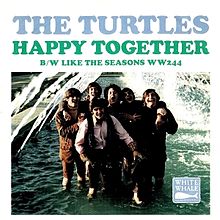
One thought on “Hot Stove #97 – Thank You Charles Curry, Alex Petrovic and Charlie Wheeler – Harry S. Truman Sports Complex”
Comments are closed.